Truck Camper Magazine talks with Jack Kay, President of Torklift International, about the concepts, terms, and calculations required for towing with a truck camper rig. Don’t tow with a camper until you read this article.

Truck and truck camper rigs have long been celebrated as the most versatile RVs on the planet. Want to go anywhere a pickup truck can go? Want to have four-wheel drive for off-road capability? Want to camp off-grid for extended periods of time? Want to tow a trailer, boat, or vehicle? You need the unrivaled versatility of a truck camper.
With this versatility comes an increased responsibility. First and foremost, you are responsible for assembling a safe truck and camper match. This means making the right truck and camper choices for camper weight, truck payload, center of gravity location, and overall fit compatibility.
To make the truck and camper matching process as simple as possible, we have a cleverly titled step-by-step article titled, “How To Match A Truck and Truck Camper“. That article is a must read for every truck camper enthusiast, but what if you also want to tow?
Towing adds a number of additional considerations to the matching process. For example, you need to account for the towing capacity of your truck with the loaded camper, and the Tongue Weight of the trailer, boat, or vehicle you plan to tow.
For years we have helped Truck Camper Magazine readers with proper truck and camper matching, and referred the towing questions to the truck camper manufacturers and dealers on the front line. Unfortunately, not every truck and truck camper dealer is knowledgeable about towing, or is willing to take the time and care required to set up customer’s rig correctly.
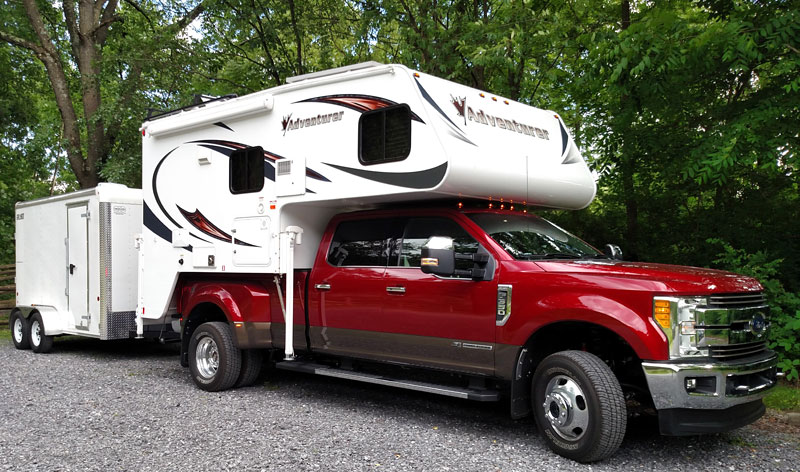
About once a week, someone at Truck Camper Magazine headquarters would say, “We really need to do an article on towing with a truck camper”. I think even our cat, Harley, meowed it once or twice. The challenge was our relative lack of knowledge on towing. With a topic as important as this, who could we ask for help?
There was only one person on our list; Jack Kay, President of Torklift International. In our experience, nobody on Earth understands or cares about towing with a truck camper more than Jack. More importantly, Jack shares our priorities of customer safety and following the law. Even better, he was as excited about doing this right as we were.
With Jack onboard, we scheduled an interview with a list of the towing questions we’ve been asked by truck camping newbies; again and again. For newbies, we start with the basics and then present the tools needed to assemble a safe truck and camper towing set-up. For veterans, Jack’s interview will be a a comprehensive refresher course – with a few towing reality checks along the way.
Before we get into the specifics of towing with a truck camper set-up, how do you like to start a conversation about towing?
I like to start by stating that the truck manufacturers took many years, millions of dollars, and hundreds of engineers to develop the vehicle you are driving. We all take this for granted, but trucks are extremely complex systems designed to safely transport you and your family down the road.
I think of trucks as an ecosystem. Mess with the balance of that ecosystem and you can quickly destroy it. From this perspective, we need to be extremely careful about anything we do that alters the original design balance of the truck.
That’s probably the most important concept behind what we are going to talk about; how you can work with – not against – the manufacturer’s design and specifications of your truck to keep it safe for towing.
How does one figure out the towing capacity of their truck and camper rig?
There are five important terms required for figuring out the towing capacity for a truck camper set-up; GVWR, GAWR, GTW, TW, and GCWR.

That’s a lot of acronyms. Let’s go through them one at a time, and how they apply to a truck and camper set-up for towing. Let’s start with GWVR.
GVWR stands for Gross Vehicle Weight Rating. GVWR describes the total weight carrying capacity of a truck including the weight of the truck, occupants, cargo, camper and Tongue Weight.
What’s important to remember about GVWR is this; when you weigh a truck with its contents, the resulting weight should never exceed GVWR posted on the truck.
Truck manufacturers spend a lot of money and engineering time calculating how much weight a loaded truck can safely transport. The resulting calculations, including GVWR, involve the entire ecosystem of the truck; suspension, brakes, springs, shocks, steering system, and frame.
“You are endangering others if you are overloaded. None of us want to be a contributing factor to someone’s injuries or loss of life.”
There’s a common perception that modifying your truck’s suspension can change the GVWR of your truck. You have decades of professional experience on this subject. Can you change the GVWR of a truck?
Absolutely not. When a manufacturer brands a vehicle or trailer with a GVWR, that truck is branded for life with that GVWR. The manufacturer GVWR is permanent and can never be altered or changed.
When you overload your truck, you are outside the manufacturer’s design and tested safety factor of your truck. Once you go outside of the manufacturer’s design, you are on your own.
Please realize that you are endangering others if you are overloaded. If there is a fatality, there is going to be an accident investigation. None of us want to be a contributing factor to someone’s injuries or loss of life.
If you can’t change the GVWR of a truck, what are suspension enhancement products for?
Suspension enhancement products can help with the overall handling and dynamics of a vehicle, but overloading a truck’s GVWR is illegal.
After adding suspension enhancement products your truck may seem to drive down the road safely, but your brakes and springs were not altered. You must stay within the manufacturer’s GVWR of your truck.
Another common perception is that truck manufacturers are conservative with their GVWR. Is this true?
It probably is, but the truck manufacturers do not endorse overloading the GVWR on your truck. By overloading the GVWR on your truck, you are driving illegally, and taking your own life and the lives of others in your hands.
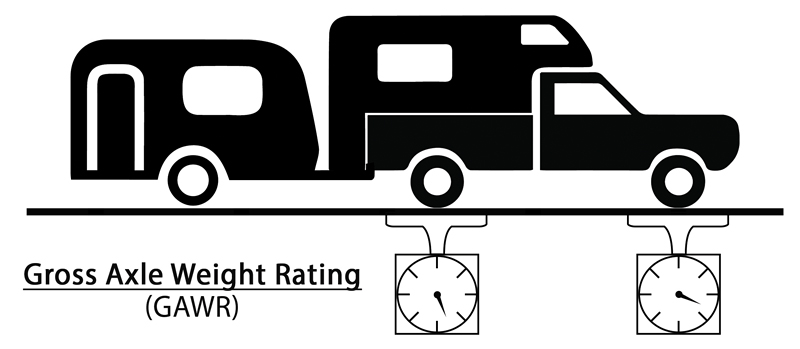
That’s very clear. We also talk about the importance GVWR in the article, How To Match A Truck and Camper. Talk to us about GAWR and how it’s an important data point for towing?
GAWR stands for Gross Axle Weight Rating. In the context of towing, GAWR describes the maximum weight an axle can safely handle.
Like GVWR, it’s critical not to exceed the GAWR for a truck or trailer axle. It’s especially important to monitor the rear GAWR of a truck in a towing set-up. If your Tongue Weight is too high, it is possible to exceed the GAWR of your truck.
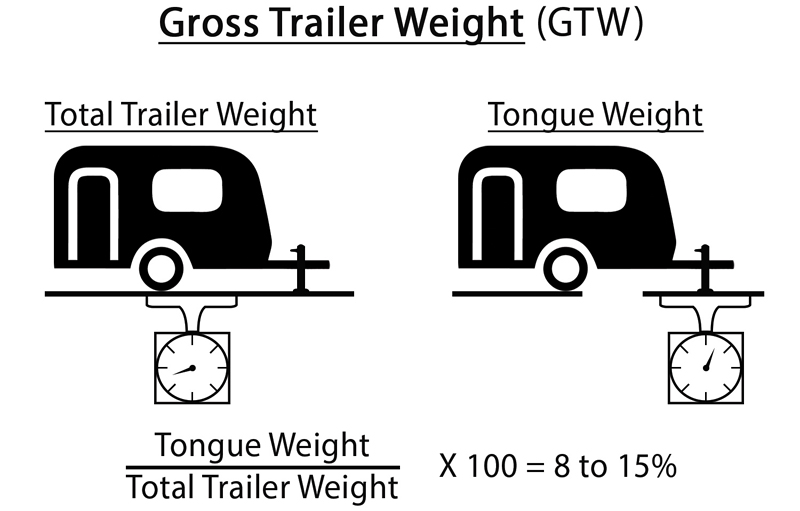
One term we have never used in Truck Camper Magazine is GTW. What is GTW and how does it factor into a truck and camper towing set-up?
GTW stands for Gross Trailer Weight. GTW describes the total weight carrying capacity of a trailer including the weight of the trailer and its cargo.
GTW is similar to GVWR (Gross Vehicle Weight Rating) only it applies strictly to trailers, not trucks. Like GVWR and GAWR, it’s important that a trailer never exceeds its GTW.
Which brings us to Tongue Weight (TW). What exactly is Tongue Weight?
Tongue Weight is the weight a trailer tongue puts on a tow hitch. Proper Tongue Weight is what makes a towing truck camper rig stable. This is incredibly important to understand for safe and stress free towing.
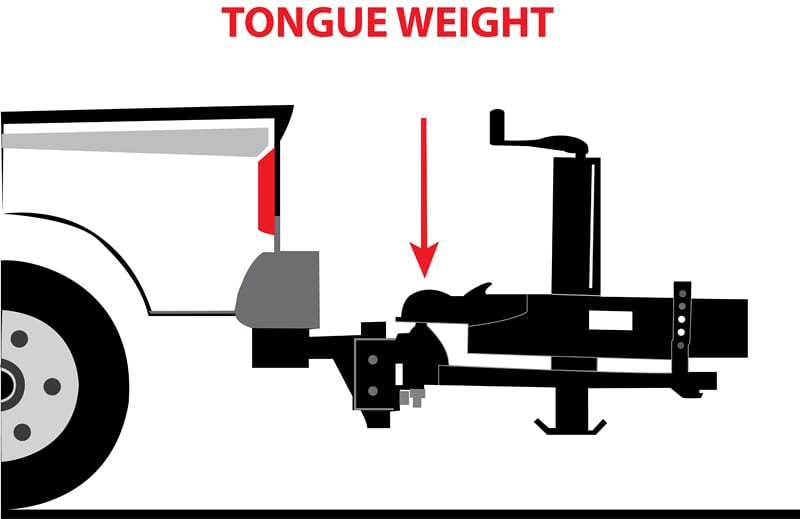
Imagine walking over to the front of your trailer’s tongue and lifting it up by the trailer’s ball coupler (the part the trailer ball fits into), and picking it up. The weight you would be lifting is the Tongue Weight. Of course most trailer tongues hitches are far too heavy for a person to lift, but you get the idea.
How does someone figure out what the Tongue Weight should be for a given trailer?
Generally speaking, Tongue Weight for single axle trailers should be somewhere between 10 and 15-percent of the Gross Trailer Weight (GTW) of that trailer. For example, if you have a 2,000 pound single-axle trailer, the Tongue Weight should be 200 to 300 pounds.
If you have a tandem trailer (two wheels in series on both sides), the Tongue Weight should be around 8-percent of your gross trailer weight. Keeping within these ratings is important to minimize the potential for sway.
Why is the Tongue Weight percent recommendation different for single-wheel and tandem trailers?
That’s a good question. Let’s imagine again that we’re picking up a trailer’s tongue by the ball coupler. If the trailer is a single axle, you could pick up the trailer’s tongue and move the trailer around like a wheel barrow.
Now try it again with a tandem axle trailer. To move the trailer, you have to force the wheels to turn. With two wheels on each side, there’s significantly more friction and the tires scrub when you move the trailer around. One of the reasons why folks like tandem multiple axle trailers is because the additional wheels can reduce sway and can allow for somewhat less Tongue Weight.

How do you determine the Tongue Weight of a trailer?
With a portable tongue weight scale. Portable Tongue Weight scales are typically around $135 and are the easiest way to quickly determine Tongue Weight.
For convenience, we recommend everyone who tows get a Tongue Weight scale. If you make changes to your tow set up as you travel, you’ll have the portable scale available to check your Tongue Weight.
You can also go to a commercial truck scale to determine Tongue Weight. To do this, drive your truck, camper, and trailer to a CAT scale or other commercial truck scale. Your truck, camper, and trailer should be fully wet with your stuff, water, fuel, etc.
For the first weigh, drive your truck onto the scale, but leave the trailer tires off the scale. For your second weigh (taken immediately after the first), unhook your trailer. When you subtract the second weight from the first, you are left with the Tongue Weight of your trailer.
That’s great that portable scales are available and – at least within the context of this hobby – rather affordable.
Another important thing to remember is that your trailer should ride level. Not having the trailer ride level can greatly impact the stability of the trailer. It can also adversely affect your Tongue Weight.
It’s also a good time to mention the benefits of a properly set-up weight distribution system. A properly set-up weight distribution system is going to redistribute 30-percent of the Tongue Weight to each of the axles; front axle of the truck, rear axle of the truck, and trailer. Weight distribution systems make a truck and trailer go down the road like one long vehicle.

That sounds ideal. Does everyone who is towing need a weight distribution system?
No. A weight distribution system is not mandatory for all towing set-ups. In general, weight distribution hitches should start to be considered for trailers that weigh 3,500 pounds or more depending on the capacity of your truck. For example, a Toyota Tacoma would definitely need weight distribution for a 3,500-pound trailer and a one ton definitely would not.
If you’re towing a boat or trailer that’s under 3,500 pounds, and you’re within the capacities of your truck and trailer, you do not need a weight distribution system. If you’re towing a trailer above 3,500 pounds, you should strongly consider a weight distribution system.
You should also consider a weight distribution system if the rear of your truck is pushed down and the front of your truck is lifted up. Towing that way significantly decreases your stopping capacity and angled up headlights blind oncoming traffic at night. Emergency stops will require a much longer stopping distance. It also impacts fuel mileage and tire wear. With a properly installed weight distribution system, these issues are resolved.
Let’s complete our towing acronyms. What is GCWR?
GCWR stands for Gross Combined Weight Rating and is a truck’s maximum allowable combined mass. That includes the mass of the truck, passengers, and cargo as well as the mass of the trailer and trailer cargo.
When you go to a CAT scale with your truck, camper, and trailer fully wet and loaded, you do not want to exceed the GCWR of your truck.

The Gross Combined Weight Rating is what the manufacturer designed the truck to handle with maximum trailer behind it. Like GVWR, GCWR is cut in stone by the truck manufacturer. There is no way to change the legal GCWR of a truck.
“Truck campers with overhangs typically require at least 450 pounds of excess payload.”
Now that we have covered the required terms, how do we go about using them to design a proper truck camper set-up for towing?
Sit down and plan out your entire rig; truck, camper, and what you plan to tow. If you carefully design your rig in advance, you won’t make an expensive mistake.
I have known too many truck camper owners who buy a truck first, and then go and get a camper. Only then do they run across a CAT scale or run the numbers and discover they don’t have enough truck for their camper, much less enough Tongue Weight capacity for what they want to tow.
Start with a plan. First, calculate the wet and loaded weight of the camper and the trailer you want to purchase. You need to know the weight of the camper you are going to haul and the trailer or toys you are going to tow so that you can purchase a truck with enough payload and towing capacity.
If you’re unsure on capacities, a free resource we have made available is the Torklift Towing App which features various towing capacity on all types of vehicles. Download for Apple here or Android here.
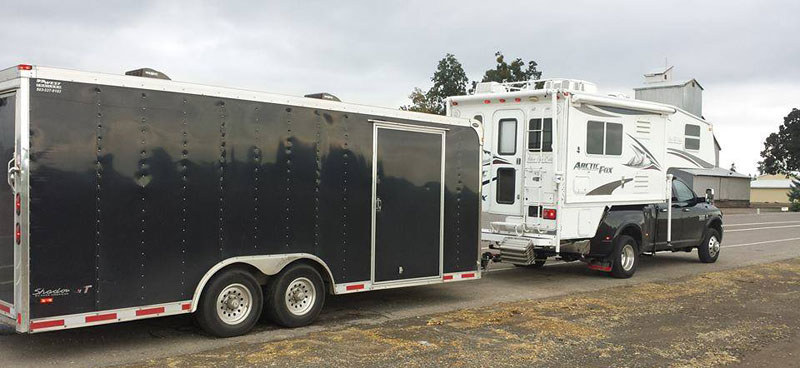
Again, our article “How To Match A Truck and Camper” helps readers to calculate the wet and loaded weight of a truck camper, even if they don’t have it yet. Many of the same concepts can be used to calculate the weight of a trailer as well.
That’s important because folks don’t always have their desired truck camper or trailer on hand to weigh.
The size of the boat you can have might not be limited by your pocketbook, but rather by the capacity of your truck and/or towing equipment. That’s why it is so important to plan out your entire rig first. If you don’t want to be limited in what you can haul and tow, you need to plan.
We say exactly the same thing about truck camper rig planning; choose your truck camper first, then get the truck to handle the wet and loaded weight of that camper. In general, how much excess payload capacity does someone need for towing?
That all depends on what’s being towed, and the tow equipment installed on the truck. As a rule of thumb, a typical truck and camper set-up needs at least 350 pounds of excess payload capacity (GVWR minus the wet and loaded weight of the rig) to be considered for towing. Truck campers with overhangs typically require at least 450 pounds of excess payload.
Most popular towed truck camper toys present several hundred pounds of Tongue Weight. For example, a smaller fiberglass fishing boat and aluminum trailer might present a 300-pound Tongue Weight. That’s typical.
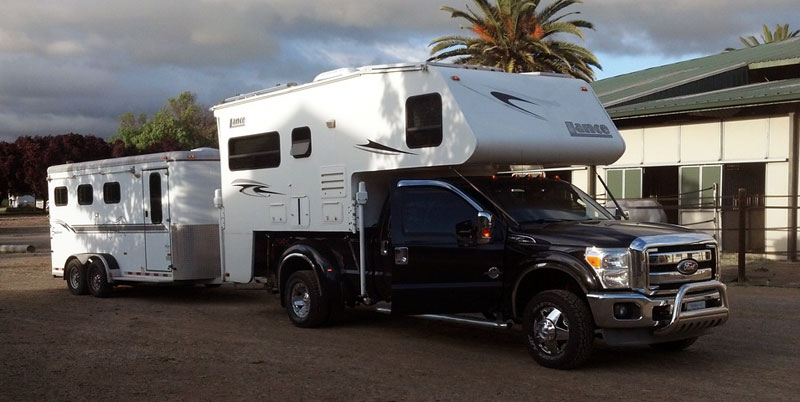
So that example truck and camper rig would need at least 300 pounds of excess payload capacity to tow that fiberglass fishing boat and aluminum trailer?
No, that’s incomplete. You need to add the weight of the tow equipment to your calculations.
The weight of towing equipment is often overlooked. For example, if you utilize your factory Class 3 hitch and your camper doesn’t require an overhang extension, you might only add an additional 50 pounds for the ball mount and mounting plate, trailer ball, coupler mount, hitch pin, safety chains, and trailer wiring.
However, if you need a larger Class 5 hitch and an extension for your camper overhang, you could add up to 150 pounds of tow equipment. Either way, the weight of your required towing equipment needs to be subtracted from your available Tongue Weight.
It makes sense that towing equipment would add a considerable amount of weight to a rig. To review, the towing tongue weight capacity of a truck camper rig is calculated by subtracting a truck’s posted GVWR from the loaded and wet weight of the camper. That gives you the Tongue Weight (TW) capacity – correct?
Yes, that’s correct. It’s also critically important that the tow equipment is rated to handle the weight of your trailer.
Let’s talk about tow equipment. There are five classes of hitches. Class 3, 4, and 5 hitches are designed for truck towing applications. How does one know what class of hitch they need?
You need to select the right hitch for the Gross Trailer Weight and Tongue Weight your truck and trailer requires.
Domestic full-size trucks typically come with a Class 3 hitch. They are rated at 8,000 pounds of Gross Trailer Weight and 800 pounds of Tongue Weight.
Class 4 hitches are rated from 10,000-12,000 pounds of Gross Trailer Weight and 1,000-1,200 pounds of Tongue Weight. Class 5 hitches are rated from 16,000-20,000 pounds of Gross Trailer Weight and of 1,600-2,000 pounds of Tongue Weight.
Anything above a Class 5, like our SuperHitch Magnum, can have a capacity up to 30,000 pounds of Gross Trailer Weight and 3,000 pounds of Tongue Weight when used with weight distribution.
“Whatever the capacity of the hitch, 10-percent of that number is tongue weight.”
You mentioned weight distribution systems earlier. How do weight distribution systems impact Gross Trailer Weight and Tongue Weight capacities?
Weight distribution systems dramatically increase the Gross Trailer Weight and Tongue Weight capacities of a hitch.
With a properly installed weight distribution system, Class 3 hitches have a maximum capacity of 8,000 to 10,000 pounds of Gross Trailer Weight.
Generally, 10-percent of the GTW gives you the Tongue Weight recommendation. Whatever the capacity of the hitch, 10-percent of that number is tongue weight. For a Class 3 hitch with a weight distribution system, 10-percent of the GTW results in a 800 to 1,000 pound Tongue Weight. Weight distribution systems make a big difference.
How does someone know that they need more than their truck’s OEM Class 3 hitch?
You can start with a Class 3 hitch, but they have a lot of limiting factors. For starters, your truck likely has more towing capacity than the hitch on the back of your truck is designed for.
If your hitch is a Class 3, but you want to tow something that requires a Class 4, you are outside the manufacturer’s safety ratings. You need to determine the minimum requirements and stay within those requirements throughout your towing set up.
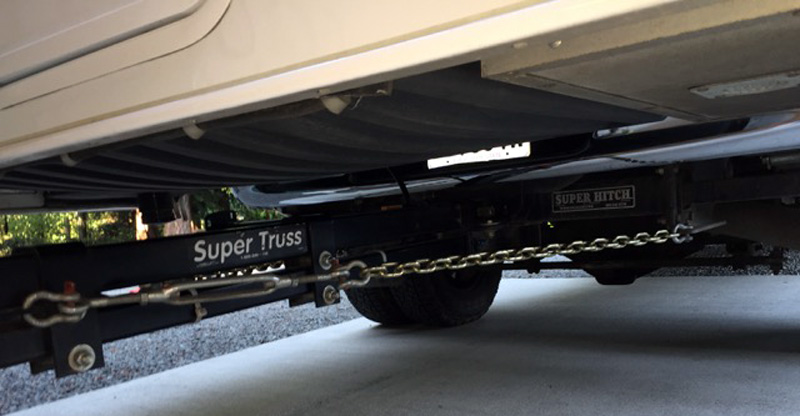
We contacted you for this article because of your personal expertise on towing with a truck camper, and Torklift International’s dedication to truck camper towing products. Take us through a typical towing set up using Torklift International products.
A truck and camper towing set-up consists of a tow vehicle, trailer, trailer hitch, tow extension, trailer ball, ballmount, hitch pin and clip, trailer coupler, safety chains or cables, and trailer wiring. Torklift International specializes in industry-leading trailer hitches, tow extensions, weight distribution systems, and required towing accessories.
Most truck campers who tow use one ton trucks for the required payload and towing capacity. For one ton trucks, I recommend the original Torklift SuperHitch 20K or the Torklift SuperHitch Magnum 30K.
With 30,000 pounds of pull weight capacity, a 3,000 pound Tongue Weight rating, and our patented dual receiver design (2.5-inch upper and 2-inch lower) the Magnum 30K essentially eliminates any concerns about hitch capacity.
Depending on the length of your truck camper’s overhang, a Torklift SuperTruss extension may also be needed. The Torklift SuperTruss extension is designed with the same load-bearing structural concept as a truss bridge.
To meet your towing needs, the SuperTruss is available in lengths from 21-inches to 60-inches. At 21-inches, a SuperTruss extension can safely tow 14,000 pounds with a 1,400 pound Tongue Weight. At 48-inches, a SuperTruss extension can safely tow 12,000 pounds with a 1,200 pound Tongue Weight. And because we build our patented products like nobody else, both products carry Torklift International’s Lifetime Warranty.
“If you stay within the stated truck, trailer, and tow equipment capacities – and install, and maintain a proper towing set-up – you are staying safe and worry free.”
We had a customer install a SuperHitch Magnum and SuperTruss on a dump truck. Unfortunately, the customer forgot the SuperTruss extension was installed and pushed the hydraulic bed down onto the SuperTruss at full force.
The SuperHitch Magnum and SuperTruss did not bend. In fact, the SuperTruss pushed into the dump truck and bent the frame. From this example and our own extensive testing, we know the SuperHitch Magnum and SuperTruss can handle their published ratings.
That must have been a very bad day for the dump truck customer. Are there any other towing factors folks should be aware of?
I like to think about all of this like the cowboys and the sheriff. In the United States, we’re a country of cowboys. We don’t always like the law. We don’t like being told what to do.
Then there’s the sheriff who is trying to maintain law and order and keep the peace. He also wants to make sure everyone is safe and happy.
If you stay within the stated truck, trailer, and tow equipment capacities – and install, and maintain a proper towing set-up – you have no fear of the sheriff, and you are staying safe and worry free.
That is the main point of our fun adventures; building memories and enjoying this amazing world we live in. At Torklift International, we are trying to keep the cowboys from having uncomfortable situations with the sheriff.
For more information about towing from Torklift International, visit their website at torklift.com. Click here to request a towing brochure.
